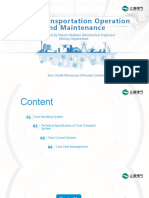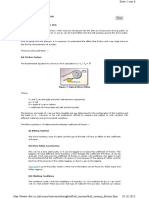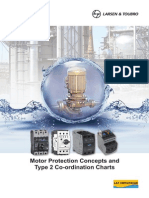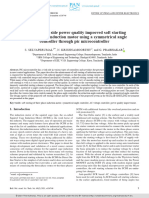Professional Documents
Culture Documents
Modern Tools For Hopper Design: by Tim Freeman, Freeman Technology
Modern Tools For Hopper Design: by Tim Freeman, Freeman Technology
Uploaded by
Rashmi RaniOriginal Description:
Original Title
Copyright
Available Formats
Share this document
Did you find this document useful?
Is this content inappropriate?
Report this DocumentCopyright:
Available Formats
Modern Tools For Hopper Design: by Tim Freeman, Freeman Technology
Modern Tools For Hopper Design: by Tim Freeman, Freeman Technology
Uploaded by
Rashmi RaniCopyright:
Available Formats
Modern tools for hopper design
By Tim Freeman, Freeman Technology
Although there are well-established methodologies for hopper design, many process engineers are uncertain as to how to measure powders in the prescribed way, extract the necessary parameters from recorded data, and successfully apply them. As a result, hopper design and the powder testing associated with it is often outsourced to specialists. This incurs significant cost and undermines the operating companys ability to troubleshoot and re-use or retrofit equipment for alternative materials or applications. The advent of modern, automated powder testing systems has simplified measurement, making it easier for users who are not instrument specialists to precisely determine the parameters required for hopper design. Recently released software for the FT4 Powder Rheometer (Freeman Technology) guides engineers through the established methodologies, showing how to use measurements to generate a specification that will operate in an acceptable way. Together these developments bring hopper design easily within the remit of the majority of process engineers, offering an opportunity to reduce costs and gain a better understanding of the factors influencing performance. Here we examine the issues surrounding hopper design and show, using a worked example, how the new software simplifies the whole process from powder measurement through to specification. The basics of hopper design In this paper the term bin refers to the section of a storage vessel with parallel sided walls, hopper is the angled portion below. A storage vessel or silo therefore consists of both bin and hopper. Many different shapes of hopper and bin are routinely used but in each case the design intent is the same: reliable, steady powder discharge, at the required rate. Selecting an appropriate outlet size and hopper half angle, the degree of incline from the vertical, of the hopper walls, achieves this aim. The resultant flow regimes can be broadly divided into two mass flow and core or funnel flow. Figure 1: Flow regimes for powders discharging from a storage silo
Modern tools for hopper design
Page 1 of 8
Half angle strongly influences the flow mode or regime that develops within the silo (see figure 1). With mass flow (the preferred option for the majority of applications) all of the powder is in motion as material is withdrawn at the exit, producing a first in, first out regime. Flow tends to be relatively consistent and the full capacity of the bin is used. With funnel flow, on the other hand, there is an active channel down the centre of the vessel but powder stagnates along the hopper and bin walls. Steeper hopper walls smaller hopper half angles encourage mass as oppose to funnel flow. Funnel flow produces last in, first out powder delivery and a greater likelihood of operational problems such as rat holing, segregation and flooding. Rat holing is where a central void develops above the discharge outlet in place of the active flow channel. The collapse of rat holes can cause significant mechanical damage and/or excessive aeration of the powder. More generally, aeration in the active flow channel encourages flooding (where the powder becomes fluid-like and flows uncontrollably) and segregation (the separation of particles on the basis of size), both of which are undesirable. While these operational disadvantages discourage the use of funnel flow it can be the preferred choice when building height is limited for example. Funnel flow designs can be short and wide, because the hopper sides are shallowly angled while mass flow units accommodating an equivalent volume tend to be taller with a smaller cross-sectional area. Design theory Powder flow behaviour in a bin and hopper is governed by: The shear properties of the powder how easily the particles move relative to each other Wall friction how easily the powder flows over the inner surface of the container Compressibility how the application of a consolidating stress changes bulk density
These variables define how the powder will behave in the hopper when consolidated by the weight of material in the bin. Potentially a stable arch can form across the hopper outlet (figure 2), and if this is strong enough to support the rest of the powder in the vessel then discharge ceases. For any given combination of powder and material of construction, hopper half angle and outlet size determine whether a stable arch can form. In the 1960s Jenike carried out a detailed flow analysis based on this flow/no flow condition, to develop a design methodology [1] which remains the standard. Figure 2: The formation of a stable arch that prevents powder flow depends on the relative size of forces acting within the hopper
Modern tools for hopper design
Page 2 of 8
A full description of the associated mathematical analysis [2] lies beyond the scope of this paper but in summary the technique involves determining two parameters: flow function (FF) and flow factor (ff). FF depends purely on the shear strength of the powder, which is measured as a function of applied normal stress using shear cell apparatus. The torque or force required to shear a consolidated powder bed across a plane is accurately determined to generate yield loci for the material from which FF is derived. Reference 3 describes shear cell testing methodology and the associated Mohrs circle analysis in some detail. Flow factor, ff, in contrast, depends on the characteristics of the hopper - material of construction, shape - as well as those of the powder, and is, for any specific hopper configuration, a function of hopper half angle, wall friction and material bulk strength. A plot of FF and ff is shown in figure 3. It is clear that both parameters describe relationships between shear strength and consolidating stress, one for the material itself (FF), the other for the material within the specific hopper environment (ff). The point at which these two curves intersect gives the value of stress in a hypothetical arch at the transition point from flow to no flow. Outlet size is calculated from this value through a simple force balance on the arch. Figure 3: A plot of FF and ff showing the intersect point defining the flow/no flow transition
It is important to recognise from this analysis that any change in the FF or ff will alter the critical dimensions of the hopper. If the material of construction, shape or half angle of one hopper is different from that of another, then a different outlet size will be needed to achieve flow, for the same powder. If the intent is to use a storage silo for a powder different from the one for which it was designed, then this will alter FF (and ff) and so half angle and outlet size may or may not be adequate. Both these conclusions are fairly obvious. However, what is perhaps less well-understood is that FF and ff may change, for a given material, depending on in-process conditions and the powder properties.
Modern tools for hopper design
Page 3 of 8
If the material segregates, for example, the hopper may have to cope with slugs of finer and coarser material, which may be more or less cohesive respectively. Moisture level too can cause a significant change in shear strength as can storage time. If the material is allowed to consolidate under its own weight for a significant period then shear strength can rise significantly (time consolidation). Repeated testing under different conditions allows the designer to assess sensitivity to such changes. The choice is then either to specify on the basis of the worst expected case, or install upstream measures to avoid variability that will compromise hopper operation. Worked example: Determining half angle and outlet diameter for a conical hopper for potato flour The new software for the FT4 guides the user through measurement, data workup and the design methodologies developed by Jenike (figure 4); in this example the design is for potato flour. Automation of every step facilitates precise powder testing and generation of an acceptable design. Figure 4: The methodology used to generate critical dimensions for a hopper
Measuring shear data to generate FF and internal angle of friction During shear cell testing the sample is consolidated at a specified pressure before measuring shear strength as a function of (lower) applied normal stresses to generate a yield locus. Different consolidation pressures are used to generate a series of yield loci from which the FF plot is derived. Figure 5 shows the plots produced by the software for the potato flour, from the shear cell data. The angle of internal friction (AIF), which is used in the calculation of ff, is derived from this test. The AIF is related to consolidating load but in the first iteration of the calculation the stress in the arch is completely unknown so it is common practice to take an average of three measurements for use in subsequent calculations, as an initial approximation. Here this generates a value of 42.7o.
Modern tools for hopper design
Page 4 of 8
Figure 5: Work up of shear test data a) shear stress as a function of applied normal stress measured at different consolidation loads b) the FF plot c) internal angle of friction as a function of major consolidating stress
Modern tools for hopper design
Page 5 of 8
Measuring wall friction data to generate wall friction angle Wall friction is characterised in an analogous way to shear strength by shearing the powder against a surface of the proposed material of construction rather than against itself. For this hopper the intent is to use 316SS with a 1.2 micron surface roughness. Test data generated using the methodologies defined within the instrument software are shown in figure 6 along with the determined value of wall friction angle: 26.3o. Figure 6: Wall friction test data
Measuring compressibility consolidating pressure
data
to
define
bulk
density
as
function
of
The bulk density of a powder can change markedly depending on the degree to which it is compressed. In general more cohesive materials exhibit greater compressibility, their structures naturally holding air which is pushed out by the consolidating pressure. Figure 7 shows the bulk density measurements of potato starch as a function of applied consolidating pressure which were made using the instruments standard bulk compressibility test. Figure 7: Compressibility data for potato flour
Modern tools for hopper design
Page 6 of 8
Calculating the design parameters Hopper half angle, and subsequently ff, are calculated directly from wall friction angle and internal angle of friction, either graphically or using (complex) equations, and found to be 15o and 1.35 respectively. Imposing the ff plot on the existing FF chart gives the intersect value required for the calculation of the stress in the arch at the no flow/flow transition point (see figure 3). Outlet size is then calculated from the equation below.
B=
Where
1 H ( ) g
B is the outlet diameter (metres) 1 is the consolidated stress generated in an arch at the outlet (kPa) H()is a function that takes account of variation in the arch thickness, hopper half angle & hopper geometric configuration is the bulk density when consolidated at 1 (kg/m3 or g/ml) g is the acceleration due to gravity (9.81m/s2)
At this point in the calculation, accuracy can be improved by assessing sensitivity to the value of internal angle of friction. The value of major consolidating stress at the point of intersection can be used to generate a more representative value of internal angle of friction compared with the original, averaged value (see figure 5c). This first iteration value, 45.5o in this case, enables the generation of a new half angle, ff, and arch stress. As subsequent iterations produce very little change feeding these figures into the equation above is acceptable. A hopper half angle of 15o is required and an outlet size of 0.59m. As with all engineering design the final results are modified to provide a margin for error. Standard practice is to decrease hopper half angle by 3o, i.e. make it steeper than the analysis suggests, and increase outlet size by 20%. This gives the following design parameters for this hopper: Hopper half angle : 12o Outlet size : 0.71m In conclusion New software in combination with modern automated powder testers demystifies hopper design from powder testing through to specification. It improves access to a well-established but complex design methodology allowing the majority of process engineers to independently and confidently specify critical hopper dimensions for any given powder. Since outsourcing hopper design, and the associated powder testing, is costly, this solution offers financial benefits, and simultaneously enhances the companys ability to successfully operate and utilise storage silos. Working through the design process generates an understanding of which factors dominate and compromise operation. Furthermore, bringing testing in-house makes it easier to assess the sensitivity of a powder and hopper design to changes induced by, for example, segregation or a varying moisture level. The developed understanding allows a hopper to be confidently re-used for alternative purposes. It also enables a process engineer to effectively assess options for modifying the process or hopper to give optimal ongoing performance.
Modern tools for hopper design
Page 7 of 8
References [1] Storage and flow of solids, Bulletin 123 of the Utah Engineering Experiment Station, November 1964 (Revised 1980), A.W.Jenike, University of Utah. [2] Basic principles of bulk solids storage, flow and handling, A.W. Roberts, The Institute for Bulk Materials Handling Research, 1993 [3] Standard Shear Testing Technique for particulate solids using the Jenike Shear cell. IChemE/EFCE, 198
April 2009 Tim Freeman Freeman Technology www.freemantech.co.uk tim.freeman@freemantech.co.uk
Modern tools for hopper design
Page 8 of 8
You might also like
- Wareflex - Investing MemoDocument2 pagesWareflex - Investing MemoThuý NgaNo ratings yet
- Threaded Fasteners 2: Shigley's Mechanical Engineering DesignDocument52 pagesThreaded Fasteners 2: Shigley's Mechanical Engineering Designarda akkayaNo ratings yet
- Dragline or Truck/Shovel? Some Technical and Business ConsiderationsDocument7 pagesDragline or Truck/Shovel? Some Technical and Business ConsiderationsKevin Satrio Adiguna100% (1)
- Janssens EquationDocument10 pagesJanssens EquationmrnaeemNo ratings yet
- 5 Roll Paper Conti James Ellton V14m PDFDocument21 pages5 Roll Paper Conti James Ellton V14m PDFRahmatwalNo ratings yet
- Genie 92sc Eng ManualDocument110 pagesGenie 92sc Eng ManualLuka LjubicicNo ratings yet
- RingfeDocument77 pagesRingfeAlejandro RojasNo ratings yet
- ZISCO Installs World LongestDocument11 pagesZISCO Installs World LongestJoshua GrahitaNo ratings yet
- Comparing Predicted To Experimentally Obtained Results PDFDocument20 pagesComparing Predicted To Experimentally Obtained Results PDFPraveen KumarNo ratings yet
- Presented at The 2010 Annual SME Meeting in Phoenix, AZDocument15 pagesPresented at The 2010 Annual SME Meeting in Phoenix, AZassaNo ratings yet
- Non Free Flowing MaterialsDocument48 pagesNon Free Flowing MaterialsHector Aguilar CorderoNo ratings yet
- 0621 vsb6 Section H Chassis PDFDocument47 pages0621 vsb6 Section H Chassis PDFkaviraj TukhooNo ratings yet
- T R Ea Tment PR OcessDocument8 pagesT R Ea Tment PR Ocessrichard gutierrezNo ratings yet
- Fenner Dunlop Industrial Products CatalogDocument56 pagesFenner Dunlop Industrial Products CatalogAnthony AngNo ratings yet
- About Fifth Wheels: If You Want To Enhance The Efficiency of Your TractorDocument17 pagesAbout Fifth Wheels: If You Want To Enhance The Efficiency of Your TractorAvinashRaiNo ratings yet
- Macalloy Cable Systems - Macalloy SC460, Macalloy GL Architectural Cable System and Macalloy GL Standard SystemDocument8 pagesMacalloy Cable Systems - Macalloy SC460, Macalloy GL Architectural Cable System and Macalloy GL Standard SystemJuan Garcia ArevalilloNo ratings yet
- Coal Transport SystemDocument78 pagesCoal Transport SystemWasim MalkaniNo ratings yet
- Analysis of Transfer Stations of Belt Conveyors With Help of Discrete Element Method (Dem) in The Mining IndustryDocument6 pagesAnalysis of Transfer Stations of Belt Conveyors With Help of Discrete Element Method (Dem) in The Mining IndustryRonaldo MenezesNo ratings yet
- Modeling Analysis and Optimization of TADocument11 pagesModeling Analysis and Optimization of TAYãbeçk MâmNo ratings yet
- Design Engineering MastsDocument27 pagesDesign Engineering Maststkbernardi6410No ratings yet
- Lecture - 1 Design PhilosophiesDocument67 pagesLecture - 1 Design PhilosophiesMohamed NkNo ratings yet
- CH 11 SlidesDocument77 pagesCH 11 SlidestasrifNo ratings yet
- Presentacion Bulk Solid HandlingDocument62 pagesPresentacion Bulk Solid HandlingMiguel Prada100% (1)
- Stockpile SegregationDocument2 pagesStockpile SegregationEdwin BatallanosNo ratings yet
- TFMPelayoLopezGRUO PDFDocument91 pagesTFMPelayoLopezGRUO PDFshivakumar bairojuNo ratings yet
- Sandwich ConvDocument11 pagesSandwich ConvVidya SagarNo ratings yet
- JK Lakshmi Cement LTD: 10 National Award For Excellence in Energy Management-2009Document25 pagesJK Lakshmi Cement LTD: 10 National Award For Excellence in Energy Management-2009albeta01No ratings yet
- LHS Training ManualDocument28 pagesLHS Training Manuallibid_rajNo ratings yet
- Enhance The Performance of Tube Grinding Mills: Let Us Employ Grinding RollersDocument5 pagesEnhance The Performance of Tube Grinding Mills: Let Us Employ Grinding RollersD S VenkateshNo ratings yet
- FEM Analysis of A Conveyor Belt On The Driving Drum of A Pipe Conveyor PDFDocument9 pagesFEM Analysis of A Conveyor Belt On The Driving Drum of A Pipe Conveyor PDFWilfredo BullonNo ratings yet
- StanexDocument2 pagesStanexSamehibrahemNo ratings yet
- Engineering Inspiration - Brake System Design CalculationsDocument17 pagesEngineering Inspiration - Brake System Design CalculationsManjeet SinghNo ratings yet
- FK Pump and FV Compressor - BrochureDocument8 pagesFK Pump and FV Compressor - BrochureJohn Lester Padilla-DacanayNo ratings yet
- Inclined Belt Conveyors For Underground Mass Mining OperationsDocument6 pagesInclined Belt Conveyors For Underground Mass Mining OperationsIsmaelNo ratings yet
- Dynamics of An Overhead Crane Under A Wind Disturbance Condition - 2014Document12 pagesDynamics of An Overhead Crane Under A Wind Disturbance Condition - 2014oscar201140No ratings yet
- Type of Failure in Conveyor SystemDocument13 pagesType of Failure in Conveyor Systemzainonayra100% (2)
- Mazzella WireRopeAtAGlance 0919Document5 pagesMazzella WireRopeAtAGlance 0919Tarek HareedyNo ratings yet
- Bin-Hooper Design-Esdep Lecture Note (Wg15)Document21 pagesBin-Hooper Design-Esdep Lecture Note (Wg15)RayGaint100% (1)
- Soportes Take UP STL Series - Rodamientos SmilovicDocument4 pagesSoportes Take UP STL Series - Rodamientos SmilovicAlejandro SmilovicNo ratings yet
- Analysis of A Grain Motion in The Transfer Area of The Belt ConveyorDocument14 pagesAnalysis of A Grain Motion in The Transfer Area of The Belt ConveyorczoobsNo ratings yet
- DeltaStak BrochureDocument8 pagesDeltaStak Brochurerichard gutierrezNo ratings yet
- Belt ConveyorsDocument10 pagesBelt ConveyorsRaja PalasaNo ratings yet
- Fenner Wedge Belt Drive Selection 299 - Friction - WedgebeltdrivesDocument22 pagesFenner Wedge Belt Drive Selection 299 - Friction - WedgebeltdrivesSubramanian ChidambaramNo ratings yet
- Costs of EqpmentsDocument7 pagesCosts of EqpmentsNishithNo ratings yet
- Almex Institute - Transitions (1!28!11)Document5 pagesAlmex Institute - Transitions (1!28!11)Luis FloresNo ratings yet
- Paper # 153 - The Appropriateness of The Transfer Size in Ag and Sag Mill Circuit DesignDocument13 pagesPaper # 153 - The Appropriateness of The Transfer Size in Ag and Sag Mill Circuit Designcuberbill1980No ratings yet
- Sidewall Splicing MechanicalDocument11 pagesSidewall Splicing MechanicalTamer EmamNo ratings yet
- Effect of Aggregate Inhomogeneity On Mechanical Properties of Asphalt MixturesDocument460 pagesEffect of Aggregate Inhomogeneity On Mechanical Properties of Asphalt Mixturesalfredo torresNo ratings yet
- 08 A Critical Review of Grinding Design Procedures For The 21st CenturyDocument3 pages08 A Critical Review of Grinding Design Procedures For The 21st CenturyAbhay BodhmageNo ratings yet
- Modern Technological Developments in The Storage and Handling of Bulk Solids - EditDocument26 pagesModern Technological Developments in The Storage and Handling of Bulk Solids - Editpavan317No ratings yet
- Bearing, Shear, and Tear-Out Stress?: What's The Difference BetweenDocument2 pagesBearing, Shear, and Tear-Out Stress?: What's The Difference BetweenFitra VertikalNo ratings yet
- Dynamic Design Grinding MillsDocument11 pagesDynamic Design Grinding MillsBitbitterNo ratings yet
- 24941-100-30R-G01-00073 Tunra 6299 Report FinalDocument96 pages24941-100-30R-G01-00073 Tunra 6299 Report FinalcmahendrNo ratings yet
- Chassis MechanicsDocument37 pagesChassis Mechanicsneerajsingh000007No ratings yet
- Belt Tension TheoryDocument6 pagesBelt Tension TheoryPedro ViegasNo ratings yet
- Column DesignDocument9 pagesColumn Designbasu_soumen2011No ratings yet
- FT JOB 303 Modern Tools For Hopper Design PDFDocument8 pagesFT JOB 303 Modern Tools For Hopper Design PDFhuyNo ratings yet
- White Paper Powder FlowDocument6 pagesWhite Paper Powder FlowCamii RomeroNo ratings yet
- Hopper Design Principles - Jenike & JohansonDocument12 pagesHopper Design Principles - Jenike & JohansonmlinfpcNo ratings yet
- Hopper Design Principles - Chemical EngineeringDocument24 pagesHopper Design Principles - Chemical EngineeringMohammad Ali TaghdiriNo ratings yet
- Doctoral ThesisDocument21 pagesDoctoral ThesisAnShiNeeNo ratings yet
- Big Data AssignmentDocument13 pagesBig Data AssignmentRashmi RaniNo ratings yet
- Excel Sensitivity ExplainedDocument32 pagesExcel Sensitivity ExplainedRashmi RaniNo ratings yet
- Management Accounting Group ProjectDocument48 pagesManagement Accounting Group ProjectRashmi RaniNo ratings yet
- Philips Vs MatsushitaDocument32 pagesPhilips Vs MatsushitaRashmi RaniNo ratings yet
- Knowing When To Sell - Critical ReviewDocument3 pagesKnowing When To Sell - Critical ReviewRashmi RaniNo ratings yet
- OB Group7 NestleDocument8 pagesOB Group7 NestleRashmi RaniNo ratings yet
- Greek SeismologyDocument131 pagesGreek SeismologyRashmi RaniNo ratings yet
- Financial Analysis of Indian Pharma Industry: Management Accounting ProjectDocument28 pagesFinancial Analysis of Indian Pharma Industry: Management Accounting ProjectRashmi RaniNo ratings yet
- Central TransportDocument1 pageCentral TransportSuman Reddy SNo ratings yet
- Self-Priming Centrifugal Pumps What You Need To Know PDFDocument2 pagesSelf-Priming Centrifugal Pumps What You Need To Know PDFhumshkhNo ratings yet
- All Electrical InterviewDocument20 pagesAll Electrical InterviewramprakashpatelNo ratings yet
- Rock Shox Recon TORA User ManualDocument8 pagesRock Shox Recon TORA User ManualAjay PanchalNo ratings yet
- Cadence T Single Use TFF Modules USD2896 enDocument24 pagesCadence T Single Use TFF Modules USD2896 enSarunasNo ratings yet
- 13.MCB For Motor ProtectionDocument48 pages13.MCB For Motor Protectionrajinipre-1No ratings yet
- Solution To Linear Equation-Inequality LP - JomDocument4 pagesSolution To Linear Equation-Inequality LP - JomJomar De ChavezNo ratings yet
- UncertaintyDocument27 pagesUncertaintyALIKNFNo ratings yet
- LG Manual Aires Acond PDFDocument16 pagesLG Manual Aires Acond PDFMario MillerNo ratings yet
- 3 Guidelines, Content - Process of VEDocument21 pages3 Guidelines, Content - Process of VEsatyanandaramNo ratings yet
- Scoping: Integrated Environmental Management Information SeriesDocument14 pagesScoping: Integrated Environmental Management Information Seriesaditya2053No ratings yet
- Box JackingDocument43 pagesBox JackingDr. Manamohan R KalgalNo ratings yet
- Thought Mastery Vocab Text PDFDocument2 pagesThought Mastery Vocab Text PDFYahya MahmoudNo ratings yet
- The Writing ProcessDocument59 pagesThe Writing ProcessKarl BilangNo ratings yet
- DACDocument33 pagesDACSamsuzzaman TutulNo ratings yet
- Metacognitive Strategies in Second Language LearningDocument8 pagesMetacognitive Strategies in Second Language Learningisabell_camillo67% (9)
- 05 MENZOLIT Les Apports Du SMC - 0Document43 pages05 MENZOLIT Les Apports Du SMC - 0Hatim HajiriNo ratings yet
- The Propulsion & Manoeuvring Concept of The BCF-Super C - Class Double End FerriesDocument8 pagesThe Propulsion & Manoeuvring Concept of The BCF-Super C - Class Double End FerriesLelosPinelos123No ratings yet
- Testing The Hardness of MetalsDocument5 pagesTesting The Hardness of MetalsAwanNo ratings yet
- Bill Book SystermDocument10 pagesBill Book SystermNiraj MishraNo ratings yet
- Lecture 10Document42 pagesLecture 10Hanan SajidNo ratings yet
- A Novel Source Side Power Quality IDocument12 pagesA Novel Source Side Power Quality IAfonso AbreuNo ratings yet
- 8 US Soldiers Disappear Removing 5000 Yr Old Flying Machine From Afghan Cave (Video) - AlternativeDocument2 pages8 US Soldiers Disappear Removing 5000 Yr Old Flying Machine From Afghan Cave (Video) - Alternativekrmass250% (1)
- Mkchap 4Document9 pagesMkchap 4malmir_sNo ratings yet
- ILC Assessment of Learning MAThDocument13 pagesILC Assessment of Learning MAThMd Hasan ImamNo ratings yet
- Parker, 2001 - Maritime LandscapesDocument21 pagesParker, 2001 - Maritime LandscapesGabriel Cabral BernardoNo ratings yet
- Robert Smith: Senior Service Delivery ManagerDocument2 pagesRobert Smith: Senior Service Delivery ManagerIT SOLUTION PROVIDERNo ratings yet
- Error TerrorDocument1 pageError TerrorIrina VadanNo ratings yet

































































































